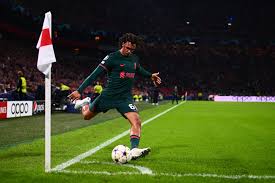A corner kick in soccer is one of the most exciting and crucial set-pieces in the game. When executed correctly, it can lead to a perfect goal-scoring opportunity. But what makes a corner kick so effective? Is it pure skill, or is there a science behind it? Let’s dive into the physics, biomechanics, and strategies that contribute to the “perfect” corner kick.
1. The Physics of a Curved Ball
When taking a corner kick, the goal is often to bend the ball into the perfect spot for teammates to capitalize on. This is where the Magnus Effect comes into play. The Magnus Effect is a phenomenon in fluid dynamics where a rotating ball creates a pressure difference in the air around it.
When a player strikes the ball with spin, the air on one side of the ball moves faster than the other, creating a low-pressure area on one side and high pressure on the other. This pressure differential causes the ball to curve.
- Outward Curve: If the ball is kicked with a side spin, it will curve away from the player, typically towards the far post or the edge of the penalty area.
- Inward Curve: A curling ball with inside spin will move in the opposite direction, typically heading toward the near post.
The key to a perfect corner kick is the ability to control the spin, trajectory, and speed of the ball, allowing it to curve in a way that’s difficult for defenders and goalkeepers to predict or intercept.
2. The Ideal Kick Technique: Precision and Power
The ideal corner kick isn’t just about spin it’s also about the technique used to strike the ball. A balance between power and precision is required to create an effective delivery.
- Foot Placement: The way the ball is struck is crucial. A player must make contact with the inside of the foot to generate the necessary curve. Striking the ball with the instep, where the foot’s arch is strongest, provides more power and stability.
- Body Position: The body’s alignment also influences the direction of the kick. Players should aim to get the right balance between upper and lower body movements to achieve an accurate trajectory.
For a kicker to generate enough power while maintaining accuracy, they typically opt for a blend of inner foot placement for spin and outer foot placement for added curve and control. Most professionals combine speed with precision to make the ball bend and dip into the penalty area.
3. The Importance of Timing and Angle
Timing and angle are two more essential aspects of a perfect corner kick. Players must not only focus on the distance and curve but also on the timing of their delivery.
- Targeting: The player must place the ball with the right angle and velocity so it reaches the target area usually the head of a teammate or a dangerous spot in front of the goal. Aiming for a precise location whether it’s the near post, the far post, or a spot in the middle relies on accurate knowledge of the opponent’s defense and the positioning of teammates.
- Crossing Timing: The corner kick must be delivered in sync with the attacking players’ runs. A poorly timed cross might find no one or be easily intercepted by defenders. A well-timed ball that’s curled into the right area gives attackers the opportunity to position themselves properly for a header or volley.
4. The Role of the Goalkeeper and Defenders
The goalkeeper and defenders are crucial variables in determining the success of a corner kick. A goalkeeper’s positioning, combined with the ability to anticipate the trajectory of the ball, plays a significant role in defending against a well-executed corner.
- Goalkeeper’s Readiness: The goalkeeper will often try to anticipate the ball’s movement based on the kicker’s approach, the angle, and the body language. If the ball is too fast, the goalkeeper may struggle to react in time.
- Defensive Positioning: Defenders can either mark attackers or position themselves in zones, trying to disrupt the delivery or block the kicker’s line of sight. The timing and execution of the corner kick can make it harder for defenders to intercept the ball or challenge an aerial duel.
5. Wind and Weather Conditions
While physics and technique are essential, external factors like wind and weather conditions can significantly impact a corner kick. Wind, especially, can alter the trajectory of a ball, making it harder for the kicker to control the curl and dip.
- Wind Effect: A strong gust of wind can either push the ball further than expected or cause it to deviate. This requires a corner taker to adjust their power and angle to ensure the ball stays on course.
6. Mental Preparation and Visualizing Success
Finally, there’s a psychological aspect to the perfect corner kick. Like any high-pressure moment in soccer, mental focus is key. Successful corner takers often visualize the ideal kick before executing it, imagining the trajectory, spin, and landing spot.
- Concentration: The ability to block out distractions, anticipate defender movements, and stay composed under pressure allows a player to execute a perfect kick with confidence.
Conclusion: A Perfect Combination of Science and Skill
The science behind a perfect corner kick is an intricate balance of physics, biomechanics, and strategy. It requires precise knowledge of ball dynamics, skillful footwork, and timing, along with an awareness of external conditions and psychological readiness.
When all elements come together, a corner kick can become a weapon capable of turning a set-piece into a game-changing moment.

